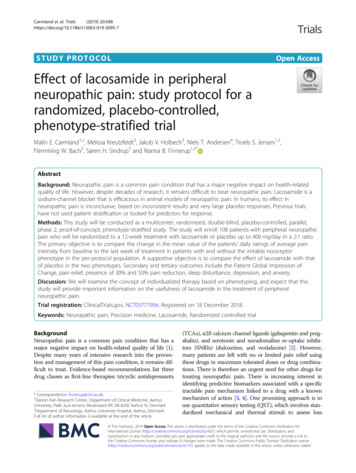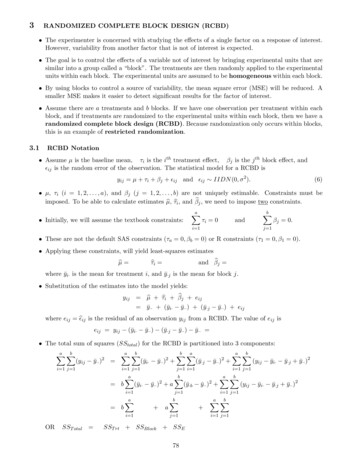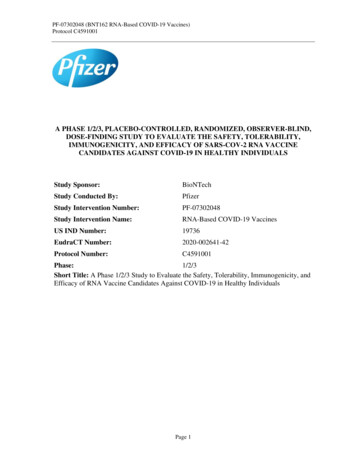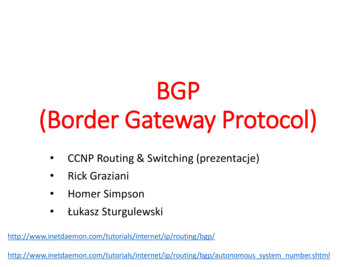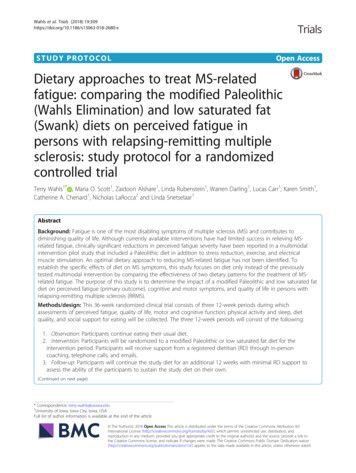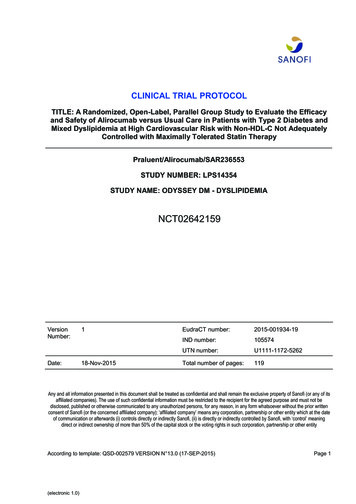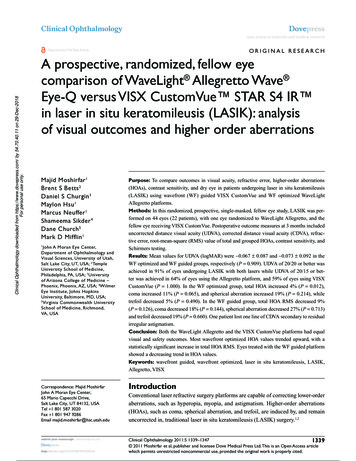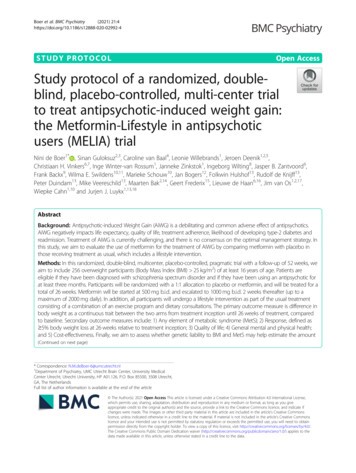
Transcription
Boer et al. BMC Psychiatry(2021) Y PROTOCOLOpen AccessStudy protocol of a randomized, doubleblind, placebo-controlled, multi-center trialto treat antipsychotic-induced weight gain:the Metformin-Lifestyle in antipsychoticusers (MELIA) trialNini de Boer1* , Sinan Guloksuz2,3, Caroline van Baal4, Leonie Willebrands1, Jeroen Deenik1,2,5,Christiaan H. Vinkers6,7, Inge Winter-van Rossum1, Janneke Zinkstok1, Ingeborg Wilting8, Jasper B. Zantvoord6,Frank Backx9, Wilma E. Swildens10,11, Marieke Schouw10, Jan Bogers12, Folkwin Hulshof13, Rudolf de Knijff13,Peter Duindam13, Mike Veereschild13, Maarten Bak2,14, Geert Frederix15, Lieuwe de Haan6,16, Jim van Os1,2,17,Wiepke Cahn1,10 and Jurjen J. Luykx1,13,18AbstractBackground: Antipsychotic-induced Weight Gain (AiWG) is a debilitating and common adverse effect of antipsychotics.AiWG negatively impacts life expectancy, quality of life, treatment adherence, likelihood of developing type-2 diabetes andreadmission. Treatment of AiWG is currently challenging, and there is no consensus on the optimal management strategy. Inthis study, we aim to evaluate the use of metformin for the treatment of AiWG by comparing metformin with placebo inthose receiving treatment as usual, which includes a lifestyle intervention.Methods: In this randomized, double-blind, multicenter, placebo-controlled, pragmatic trial with a follow-up of 52 weeks, weaim to include 256 overweight participants (Body Mass Index (BMI) 25 kg/m2) of at least 16 years of age. Patients areeligible if they have been diagnosed with schizophrenia spectrum disorder and if they have been using an antipsychotic forat least three months. Participants will be randomized with a 1:1 allocation to placebo or metformin, and will be treated for atotal of 26 weeks. Metformin will be started at 500 mg b.i.d. and escalated to 1000 mg b.i.d. 2 weeks thereafter (up to amaximum of 2000 mg daily). In addition, all participants will undergo a lifestyle intervention as part of the usual treatmentconsisting of a combination of an exercise program and dietary consultations. The primary outcome measure is difference inbody weight as a continuous trait between the two arms from treatment inception until 26 weeks of treatment, comparedto baseline. Secondary outcome measures include: 1) Any element of metabolic syndrome (MetS); 2) Response, defined as 5% body weight loss at 26 weeks relative to treatment inception; 3) Quality of life; 4) General mental and physical health;and 5) Cost-effectiveness. Finally, we aim to assess whether genetic liability to BMI and MetS may help estimate the amount(Continued on next page)* Correspondence: N.M.deBoer-6@umcutrecht.nl1Department of Psychiatry, UMC Utrecht Brain Center, University MedicalCenter Utrecht, Utrecht University, HP A01.126, P.O. Box 85500, 3508 Utrecht,GA, The NetherlandsFull list of author information is available at the end of the article The Author(s). 2021 Open Access This article is licensed under a Creative Commons Attribution 4.0 International License,which permits use, sharing, adaptation, distribution and reproduction in any medium or format, as long as you giveappropriate credit to the original author(s) and the source, provide a link to the Creative Commons licence, and indicate ifchanges were made. The images or other third party material in this article are included in the article's Creative Commonslicence, unless indicated otherwise in a credit line to the material. If material is not included in the article's Creative Commonslicence and your intended use is not permitted by statutory regulation or exceeds the permitted use, you will need to obtainpermission directly from the copyright holder. To view a copy of this licence, visit http://creativecommons.org/licenses/by/4.0/.The Creative Commons Public Domain Dedication waiver ) applies to thedata made available in this article, unless otherwise stated in a credit line to the data.
Boer et al. BMC Psychiatry(2021) 21:4Page 2 of 11(Continued from previous page)of weight reduction following initiation of metformin treatment.Discussion: The pragmatic design of the current trial allows for a comparison of the efficacy and safety of metformin incombination with a lifestyle intervention in the treatment of AiWG, facilitating the development of guidelines on theinterventions for this major health problem.Trial registration: This trial was registered in the Netherlands Trial Register (NTR) at https://www.trialregister.nl/trial/8440 asNTR NL8840 on March 8, 2020.Keywords: Antipsychotic-induced weight gain (AiWG), Schizophrenia, Metformin, LifestyleBackgroundAntipsychotics are the mainstay treatment modality forschizophrenia. Antipsychotic-induced Weight Gain (AiWG)is a debilitating and prevalent adverse effect. Antipsychoticsare associated with weight gain, lipid and glucose dysregulation and therefore increase the risk for the development ofmetabolic syndrome (MetS) [1–5]. After the initation of antipsychotic treatment in medication-naïve patients, the averageincrease in Body Mass Index (BMI) is 1.8 units in 12 weeksand 3.9 units in 48 weeks [6]. The relative risk for obesity isup to two in schizophrenia patients using antipsychoticscompared to the general population [7]. The increased obesity rate in schizophrenia patients can be mainly attributed tothe use of antipsychotics [8]. Obesity is a major health problem resulting in increased morbidity and mortality, thus decreasing life expectancy and increasing pressure onhealthcare budgets [9, 10]. Schizophrenia patients have a reduced life expectancy of 20% compared to the general population and approximately one third of patients withschizophrenia have MetS [5, 11]. Moreover, the relative riskof MetS for people with severe mental illness is 1.58 compared to the general population [11]. Importantly, all antipsychotics are to variable degrees associated with AiWG. Forexample, in a retrospective study of many antipsychotics,AiWG was highest for olanzapine with 4.2 kg and lowest foramisulpride at 1.8kgs measured over a period of 3 years [12].Aripiprazole and haloperidol have been reported to result inrelatively mild or in some studies no AiWG. AiWG alsonegatively impacts quality of life, treatment adherence, likelihood of developing type-2 diabetes and readmission rate[13–15]. Considering the growing mortality gap betweenschizophrenia patients and the general population, additionalmanagement strategies to increase the life expectancy ofschizophrenia patients are necessary [16].Despite these broad clinical implications of AiWG,treatment of AiWG has not yet been optimized. Mostguidelines, including the Dutch national guideline forschizophrenia, recommend the following interventionsfor AiWG: 1) switching of antipsychotic; or 2) weight reduction through lifestyle interventions (diet and exercise) [17]. The impact of switching antipsychotictreatment is limited as the vast majority of antipsychotics is associated with weight gain [18]. Weightreduction through lifestyle interventions is viable butknown for its relatively variable efficacy. For example, arecent study found a statistically significant effect of lifestyle interventions on weight in people with severe mental illness that was considered clinically insignificant,while a meta-review of meta-analyses found individuallifestyle counselling and exercise alone (i.e. planned,structured intensive physical activity) as the most effective weight reduction intervention in patients withschizophrenia [19, 20]. Of note, integrated interventionscombining multiple lifestyle components (e.g. exerciseand diet) delivered by qualified professionals (e.g.dietitian, exercise professionals) may be most effectivefor health-related outcomes and adherence, althoughsuch interventions have been less studied yet [21–23]. Inthis context, many guidelines, including the 2018 WHOguidelines and the Dutch national guideline for schizophrenia, recommend lifestyle interventions as first-linestrategy for the management of physical health in peoplewith severe mental illness, including AiWG [17, 24].However, given the extensive challenge to clinically significantly reduce AiWG and the only partial contribution of lifestyle interventions to help lose weight, there isa clear need for additional (combined) strategies to manage AiWG.Metformin is a promising agent in the treatment ofAiWG. Metformin generally promotes satiety and increases Glucagon-like Peptide (GLP-1), thus oftenresulting in reduced energy intake [25]. Clozapine reduces the production of GLP-1 and therefore is a viable treatment option for clozapine-induced weightgain [25]. Meta-analyses conclude that of all agentsstudied as monotherapy for AiWG, metformin is mosteffective in attaining weight loss for child and adolescent schizophrenia patients and for those patientswho use clozapine [26, 27].Recently, a meta-analysis investigated the combinationof metformin and lifestyle interventions as a treatmentfor AiWG, reporting only one double-blinded trial onthis topic [28, 29]. Additionally, five open label studieswere included, published in Chinese journals which arenot indexed by Pubmed and found to be of poor quality[29–34]. That double-blinded, well powered randomized
Boer et al. BMC Psychiatry(2021) 21:4controlled trial of sufficient quality comparing lifestyleinterventions with and without concomitant use of metformin in Chinese antipsychotic users found metformin,lifestyle interventions and the combination of metforminand lifestyle interventions to be superior to placebo [28].The best results on body weight, waist circumferenceand BMI were obtained for the combination of lifestyleplus metformin. Important limitations of that trial andany previous trials of AiWG done with metformin arethe strict inclusion criteria with regards to diagnosis (noother diagnoses than first-episode schizophrenia allowedin that previous trial) and the amount of AiWG, thusnot adequately reflecting schizophrenia patients encountered in general practice [28]. Furthermore, a very extensive exercise program (seven times a week) wasimplemented in this trial and we question the applicability of such an intensive intervention. Moreover, the duration of treatment was short (12 weeks) and the doses ofmetformin were relatively low (mostly around 1000 mgdaily), even though efficacy may be better with higherdoses without a negative impact on tolerance [35, 36].Finally, all aforementioned trials were conducted beforethe COVID-19 pandemic, which has heavily impactedboth research and clinical activities across the globe.Particularly lifestyle sessions with many individuals,often placed in the same indoor space, are challenging toconduct in the current era with social distancing andlockdowns in place in several countries and the possiblescenario of a future virus affecting global health.ObjectivesIn sum, the treatment of AiWG is currently very challenging and few interventions have been investigated in wellpowered trials of sufficient quality. Therefore, this randomized, double blind, multicenter, placebo-controlled,pragmatic trial aims to evaluate the effect of metformindoses up to 2000 mg daily for AiWG as an additionalstrategy next to treatment as usual including lifestyle interventions, by comparing metformine plus the lifestyleintervention with placebo plus the lifestyle intervention. Inthe event of a significantly greater reduction of AiWG following metformin use in combination with care as usualincluding a lifestyle intervention, guidelines can includemetformin for AiWG. Furthermore, we aim to investigatethe difference in metformin-associated reduction ofAiWG between participants using clozapine versus otherantipsychotics; between participants on high-AiWG riskagents (i.e. olanzapine, clozapine, quetiapine, risperidoneand paliperidone) compared to all other antipsychotics;and the difference between self-reported weight gain dueto antipsychotic use versus weight gain due to other reasons [2, 12]. At last, we aim to examine whether lifestyleinterventions in combination with metformin or placeboimprove metabolic traits, quality of life, general physicalPage 3 of 11and psychological health, cost effectiveness, and whethergenetic liability to BMI and MetS allows adequate estimation of weight reduction following initiation of metforminand lifestyle interventions.Metformin and placebo both combined with treatmentas usual including lifestyle interventions are the conditions we wish to evaluate with difference in body weightas the primary outcome measure. We hypothesize thatmetformin given adjunctively to lifestyle interventionswill lead to a higher level of weight reduction and betterquality of life, compared to placebo in combination withlifestyle interventions.MethodsStudy settingThis multi-center trial will be conducted at the UniversityMedical Centre Utrecht (UMCU), Mondriaan MentalHealth Maastricht and GGNet Mental Health in theNetherlands. The estimated duration of this study is 3.5years (including a participants’ enrolment phase) and participants will be followed-up for 52 weeks. The study hasbeen approved by the Medical Research Ethics CommitteeUtrecht and was registered at the Netherlands Trial Register (NL8840). The study will be conducted according tothe principles of the Declaration of Helsinki (amendedversion in October 2013) and following Good ClinicalPractice guidelines from the European Medicines Agency(ICH E6, R2) and the Medical Research Involving HumanSubjects Act (WMO).Study populationOne hundred tewnty-eight participants with a schizophrenia spectrum disorder will be followed-up for 26 weeks.With an estimated attrition rate of 50% based on attritionrates of previous trials targeting schizophrenia patients, atotal of 256 participants will be recruited from the participating and referring centres in the Netherlands (see ‘sample size calculation’ below) [37]. Two groups of subjectswith psychotic disorders will be recruited: 1) generalpatients suffering from psychosis who use a range of antipsychotics; and 2) those considered (relatively) treatmentresistant who are treated with clozapine. We specificallychose both patients on clozapine and patients on otherantipsychotics given possible differences in the efficacy ofmetformin for both patient groups: metformin may be aparticularly viable treatment modality for clozapineinduced weight gain as clozapine-induced decreases inGLP-1 may be partially offset by metformin’s GLP-1 increasing effects [25]. Eligibility of all possible participantswill be determined following intake questions, physicalexamination and laboratory findings. Should any of the results from the intake visit require immediate attention, thetreating physician will contact the participant’s generalpractitioner (GP).
Boer et al. BMC Psychiatry(2021) 21:4Page 4 of 11RecruitmentParticipating and referring sites will be recruiting. Atparticipating sites, participants will be recruited by treating psychiatrists, psychologists and general practitioners.The participants will be informed and asked for writteninformed consent by a research-physician or P.I.Referring sites provide contact details of possible eligibleparticipants to participating sites after the patient hasprovided consent. In addition, referring sites will askparticipants for their consent that a participating sitecan approach the participant. Referring sites have nopart in the inclusion process. Referring and participatingsites can use posters and brochures to recruit eligibleparticipants. Furthermore, physician brochures will beused to inform treating physicians and to support theprocess of recruitment. Enrolment of participants,obtaining informed consent and randomization will beperformed by authorized personnel of the research teamof participating sites.Inclusion criteria1. Diagnosis of schizophrenia spectrum disordersaccording to DSM-IV-TR or DSM-5 criteria assummarized in DSM-IV or DSM-5 chapter Schizophrenia Spectrum and other Psychotic Disorders,except for substance/medication-induced psychoticdisorder, psychotic disorder due to another medicalcondition, catatonia associated with another mentaldisorder, catatonic disorder due to another medicalcondition, and unspecified catatonia;2. Antipsychotic use for at least 3 months (as mostAiWG occurs in the first weeks to months oftreatment);3. Willingness to participate in a lifestyle intervention;4. Dutch speaking and reading;5. Mentally competent according to the treatingphysician;6. Able to give informed consent;7. At least 16 years of age;8. Overweight (BMI 25).Exclusion criteria1. Neurodegenerative extrapyramidal disease;2. Metformin-related contraindications: i.e.,conditions predisposing to tissue hypoxia (suchas congestive heart failure, recent myocardialinfarction and respiratory failure), metabolicacidosis, precoma diabeticum, kidney failure(glomerular filtration rate (GFR) 30 ml/min)and conditions predisposing to kidney failure (e.g.dehydration, infections and hypovolemic shock),disorders in the use of alcohol defined as two3.4.5.6.reported consumptions daily and/or a gammaglutamyltransferase (GGT) of over 60 U/L, andliver failure;Current use of medication(s) that inhibit(s)metabolism of metformin or otherwise interactswith metformin (in particular those with possibledetrimental effects on kidney functioning):-Non-steroidal anti-inflammatory drugs (NSAIDs).-Angiotensin converting enzyme-inhibitors (ACEinhibitors).-Angiotensin receptor blockers (ARBs).-Diuretics.-Organic cation transporters (OCT) -1 and 2inhibitors (e.g. cimetidine, dolutegravir,isavuconazol, trimethoprim, vandetanib,crizotinibib, vandetanib, and verapamil) andinductors (e.g. rifampicin);Vitamin B12 deficiency defined as a Vitamin B12serum level of 148 pmol/L [38];Diabetes mellitus according to NHG-criteria [39];Pregnant or breast feeding women or women ofchild bearing age using no contraceptives.Randomization and blindingAfter eligibility screening and providing written informed consent, participants will be randomized usingblock-randomization with a 1:1 allocation to 1) placebo;or 2) metformin. Randomization will be stratified forclozapine use versus other antipsychotic use additionalto stratification for participating sites using a computergenerated double-blind application developed by theUMC Utrecht’s Data Management department. Theblock sizes will not be disclosed. Allocation concealmentwill be facilitated by releasing the randomization codeonly after the participant has completed all baseline assessments and has been included in the trial.The participant, caregiver, investigator and outcomeassessor will be blind to treatment allocation. Placebotablets will be matched to metformin tablets in size andappearance. Unblinding for all participating sites will beperformed by the study sponsor whenever needed forsafety reasons. For this purpose, a set of sealed envelopescomprising the information on the type of medicationstored in every medication box used in the trial will besent to the UMC Utrecht pharmacy. This pharmacy willprovide a 24/7 backup emergency unblinding service.Participants will be excluded from subsequent statisticalanalyses after unblinding of the treatment allocation.Trial designThe trial will take place in a 52-week timeframe, including 26 weeks of treatment in both randomization groups.Metformin will be started at 500 mg b.i.d. (oral) and escalated to 1000 mg b.i.d. (4 tablets of 500 mg ( 2000
Boer et al. BMC Psychiatry(2021) 21:4mg)) 2 weeks thereafter. For participants aged 16–18years, metformin dosage will be escalated to 500 mgb.i.d. maximum. Participants will undergo 4 main faceto-face visits after 0, 13, 26 and 52 weeks, as well as oneshort telephone visit after 2 weeks to evaluate the studymedication dose (Table 1). Meanwhile, participants willundergo a lifestyle intervention that is considered careas usual in the participating centers. The study medication will start in the same seven days as the lifestyleintervention. The lifestyle intervention will exist of acombination of an exercise program and dietary interventions. The dietary intervention consists of five consultations with a dietitian in the first 26 weeks oftreatment to stimulate both healthy food and appropriate caloric intake. The exercise program exists of minimally 60 min per week of unsupervised exercise by choice(i.e. walking, dancing, cycling or jogging). Also, participants gather in weekly lifestyle group sessions coachedby an exercise professional with affinity in mentalhealthcare for low-intensity exercise including weeklyweight measurements and assessment of physical activityusing the Physical Activity Vital Sign questionnaire(PAVS) [40, 41]. Due to the COVID-19 pandemic, theweekly lifestyle sessions will be offered online. Participants may wish to discontinue lifestyle interventions atany moment and still continue with the current trial.Considering that some participants will discontinue lifestyle interventions in clinical practice, participants maycarry on with the trial following the pragmatic design ofthis study to obtain results resembling clinical practice.Similarly, patients may continue with the trial afterswitching or stopping antipsychotic use. Patients shouldbe on an antipsychotic at the start and may use any additional medicines except for medication(s) that inhibit(s)metabolism of metformin (e.g. bictegravir, cobicistat,daclatasvir, dolutegravir and vandetanib) or otherwiseinteract(s) with metformin (in particular those with possible detrimental effects on kidney functioning, e.g.NSAIDs, ACE-inhibitors, diuretics and intravascular iodine). Therefore, participants using the aforementionedmedication will be excluded from this trial. Changes inmedication use will be registered at each visit. Information regarding adherence to medication, dietary and exercise interventions is obtained by self-report duringvisits after 13 and 26 weeks. In addition, pill counts areused to assess medication use adherence. Participantsare considered compliant in case of a pill count of 80%[42, 43]. The adherence ratio will be calculated by thedifference in the number of pills provided at visit 1 andthe remaining pills at visit 3 and again between thenumber of pills provided at visit 3 and the remainingpills at visit 4 divided by the prescribed number of pills.This result will be multiplied by 100. To improve participant retention, participants will receive financialPage 5 of 11reimbursement for travel costs and 10 euros for eachvisit. Furthermore, the research team actively involvedtwo experienced experts and patient association Anoiksisin the conceptualization and design of this study to ensure the design is patient-friendly, reflective of clinicalpractice and beneficial to patients.AssessmentsVisit 1During visit 1, baseline demographic characteristics willbe assessed. Medical history including medication-, alcohol, tobacco- and substance use, weight before the startof mental illness, weight before the initiation of antipsychotic use and the estimated amount of weightgained due to antipsychotic use is also collected. TheM.I.N.I. plus section M is used to assess the criteria forschizophrenia [44, 45]. All elements of MetS (i.e. bodyweight and height, BMI, waist circumference, and systolic and diastolic blood pressure) are measured during ashort physical examination. The 6 Minutes Timed Walking Test (6MTWT) and Simple Physical Activity questionnaire (SIMPAQ) are used to assess physicalendurance and physical activity, respectively [46]. Bloodglucose levels are measured using a capillary blood fingerdipstick and urine pregnancy tests will be conductedfor women of childbearing age. Additionally, blood willbe drawn to measure C-reactive protein (CRP), GFR,Triglycerides, Low-density lipoprotein (LDL) and Highdensity lipoprotein (HDL) levels, insulin, glucose andHemoglobin A1c (HbA1c). At last, several questionnaires will be assessed during visit 1 (see ‘secondary outcomes’ below).Visit 2Visit 2 is a short visit by telephone at 2 weeks into thestudy to assess how the participant is proceeding withthe study medication, i.e. whether they have been able toswitch from the starting dose of 500 mg b.i.d. to 1000mg b.i.d. and whether they are experiencing any sideeffects.Visits 3 and 4During visits 3 and 4, adherence to lifestyle interventionsis assessed, as well as information regarding medicationuse, dose and side effects, adverse events reactions, alcohol-, tobacco- and substance use. Similarly to visit 1,physical endurance, physical activity and elements ofMetS are measured during physical examination additional to the blood glucose level using a capillary bloodfingerdipstick. Also, a urine pregnancy test and laboratory tests will be conducted. One EDTA tube (6 cc) orsaliva is optionally drawn for DNA extraction. Furthermore, the same questionnaires as during visit 1 will betaken.
Boer et al. BMC Psychiatry(2021) 21:4Table 1 Study Flow DiagramaMini-International Neuropsychiatric InterviewThe short version of the official WHO quality of life questionnairecthe 3-level EuroQol scale to describe and value healthdClinical Global ImpressioneiMTA Productivity Cost-effectiveness questionnairefiMTA Medical Consumption questionnairegBrief Psychiatric Rating ScalehCommunity Assessment of Psychic ExperiencesiSimple Physical Activity questionnairej6 Minutes Timed Walking TestkIncluding height (first visit only), weight, BMI, systolic and diastolic blood pressure, pulse, waist circumferencelIncluding CRP, GFR, LDL, HDL, triglycerides, insulin, glucose, HbA1cm ax – xb Metformin dose 1000 mg daily, xb – xc Metformin dose up to 2000 mg dailybPage 6 of 11
Boer et al. BMC Psychiatry(2021) 21:4Visit 5One year after completing study visit 1, body weight,waist circumference and blood.pressure are measured during physical examinationand the 6MTWT is performed to assess physical endurance [46]. Furthermore, information regarding medication use and the (off-label) prescription of metforminbetween 26 weeks and 52 weeks by other physicians isassessed.Primary outcome– Difference in body weight as a continuous traitbetween the two arms from treatment inceptionuntil 26 weeks of treatment.Secondary outcomesDifferences between the two arms from treatment inception until 26 weeks of treatment in:– Any element of MetS (i.e., waist circumference (cm),BMI (kg/m2), triglycerides (mmol/L), LDL (mmol/L)and HDL (mmol/L) levels in blood, blood pressure(mmHg) and HbA1c (mmol/mol)) [3].– Response, defined as 5% body weight loss at 26weeks relative to treatment inception.– Quality of life measured using the WHOQOL-BREF,a shorter version of the World Health OrganizationQuality of Life instrument [47].– Quality of life measured using the complementary 3level version of the EuroQol 5D (EQ-5D-3L) [48].– General psychological and physical health using thebrief Clinical Global Impression-Severity and-Improvent scale (CGI-S and CGI-I) [49].– General psychological and physical health using theBrief Psychiatric Rating Scale (BPRS) [50].– Potential fluctuations in depressive, positive andnegative symptoms using the The CommunityAssessment of Psychic Experiences (CAPE) scale[51, 52].– Cost-effectiveness using the iMTA Productivity CostQuestionnaire (iPCQ) and the iMTA MedicalConsumption Questionnaire (iMCQ) [53].COVID-19 measuresDuring the face-to-face visits, measures will be taken inaccordance with applicable guidelines regardingCOVID-19 if necessary to optimize safety. Face-to-facevisits can be adjusted as much as possible to online visitsor house visits if required. The weekly lifestyle sessionswill be offered online. Furthermore, the research teamwill use adequate protective equipment and will keep aphysical distance of 1.5 m wherever possible. Additionally, participants will be asked to:Page 7 of 11 keep a physical distance of 1.5 m from othersavoid handshakingcough and sneeze in the elbowpractice good hygiene (disinfect, wash hands)stay home if any cold or flu symptoms are presentcome to the face-to-face visits alone if possibleAs in practice it may not be feasible for participants toattend the next visit exactly after 13 and 26 weeks,respectively, we allow for a 4-week time window forthese visits, i.e. a participant should attend to the nextvisit within 11–15 weeks and 24–28 weeks, respectively.This is in line with clinical practice and the pragmaticnature of this trial: participants suffering from psychosisoften miss follow-up consultations (due to hospitalization,negative symptoms or symptom exacerbation) and arethen scheduled some weeks later. Furthermore, participants may be unable to attend due to COVID-19symptoms. Participants with suspected or diagnosedCOVID-19 may continue the trial whenever they are fullyrecovered within this time window.Data collectionLocal authorized investigators will enter the acquireddata and examination results into hard-copy documentsand an electronic case record form (eCRF), Castor, thatis accessible via the internet [54]. Investigators will receive personal user names and passwords for this purpose, and data will be encrypted for transfer. Theinvestigator must (electronically) sign that entries intothe eCRF are true and complete. After data has beensubmitted to the study centre, another thorough inspection of the completeness and plausibility of entries willbe conducted. If needed, clarification questions will beaddressed to the sites. Only after all questions regardingdata quality have been answered, the database will belocked.Pseudonymous (coded) data will be relayed to the central study team for scientific analysis or made available,if necessary, to the responsible supervisory authority.Only qualified and authorised collaborators of the studysponsor will enter the pseudonymous data into a computerised database. The acquired data will be used wi
this study, we aim to evaluate the use of metformin for the treatment of AiWG by comparing metformin with placebo in those receiving treatment as usual, whi ch includes a lifestyle intervention. Methods: In this randomized, double-blind, multicenter, placebo-controlled, pragmatic trial with a follow-up of 52weeks, we
